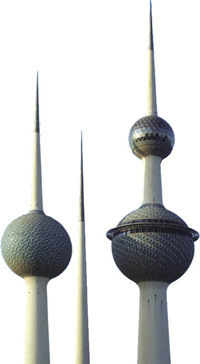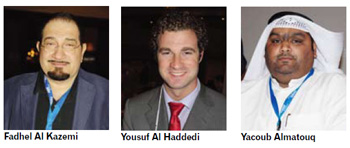A two-pronged approach to help Kuwait cope with an impending energy crisis
A two-pronged approach of regulating its nascent DC sector and an aggressive conservation campaign might help Kuwait cope with an impending energy crisis. By Pratibha Umashankar (with inputs from B Surendar)
 With a slew of district cooling summits crowding the calendar in the region, it is in danger of becoming a trend. But the Kuwait Summit, being held on January 25 and 26, is significant, because it is organised by the Ministry of Electricity and Water, proving that the powers that be are cognisant of district cooling’s relevance and necessity for the country, despite whispered misgivings about it. The summit brings together industry practitioners to discuss opportunities and challenges of the sector in the region.
With a slew of district cooling summits crowding the calendar in the region, it is in danger of becoming a trend. But the Kuwait Summit, being held on January 25 and 26, is significant, because it is organised by the Ministry of Electricity and Water, proving that the powers that be are cognisant of district cooling’s relevance and necessity for the country, despite whispered misgivings about it. The summit brings together industry practitioners to discuss opportunities and challenges of the sector in the region.
Opportunities and challenges are the two operative words here, and encapsulate the oxymoron that Kuwait and district cooling have become. The country holds around 10% of global oil reserves, yet faces domestic power concerns. It has one of the world’s highest per capita consumption rates of electricity, with residential air conditioning accounting for an estimated 70% of energy use, and chiller plants for air-cooled systems in large buildings hogging an estimated 60%. Ironically, and not surprisingly, Kuwait is staring at a possible power shortage, precipitated to some degree, by heavily subsidised power, leading to a non-existent culture of conservation. Water and power are cheap and not taxed. It is human nature to squander what comes cheap.
One option to avert an impending energy crisis is to use crude oil. But it will eat into the country’s export and revenues. Both are needed to produce more power. Thus the option is neither sustainable nor desirable.
In this scenario, district cooling offers the tantalising promise of reduction in energy use (by 50%), and a streamlined operations and maintenance regimen, not to mention improving efficiency, reliability, space saving, flexibility of air conditioning load and a longer plant life. It, thus, appears to be the obvious answer to Kuwait’s energy problems. But the answer raises several questions.
Warming to district cooling
Fadhel Al Kazemi, CEO, Kazema Global Holding, in his presentation at the Second Middle East District Cooling Summit in Doha, while speaking of a ‘grand national purpose’ Kuwait has charted for itself, revealed that sustainability, and by extension, district cooling, had been co-opted into the vision.
Yousef Al-Hadeedi, Business Development Manager at Al Kazema Holding, calling it “a national-level initiative”, says: “DC is a big solution to a very hot climate like Kuwait’s. In summer they shut down water and power to save the grid from going max out. Hence, there are generators and a very heavy cost to build water desal tanks.”
 Based on findings of a study carried out by his company and other contracting and consulting firms, Al-Hadeedi sounds a warning, “What we found is, at the rate of consumption now, if we don’t adopt district cooling, we will double or triple consumption.”
Based on findings of a study carried out by his company and other contracting and consulting firms, Al-Hadeedi sounds a warning, “What we found is, at the rate of consumption now, if we don’t adopt district cooling, we will double or triple consumption.”
Yacoub Almatouq, Refrigeration Expert with the National Ozone Unit at Kuwait’s Environment Public Authority, goes a step further. “The GCC and the Montreal Protocol community support district cooling,” he says.
Al Kazemi concurs. He used the Doha Summit to launch Tekneen District Cooling & Utilities in Kuwait. But though he made a strong case for district cooling, he also addressed the challenges that the sector in the country faced. Kuwait being a new and a late entrant, teething trouble topped the list, with other obstacles emanating from it. The country, evidently, has a strategic plan in place, but it needs to sort out specific issues to make the sector run as a well-oiled machinery.
‘DC’eptively simple
Al-Hadeedi voices this when he says that ideally, district cooling should be implemented seamlessly, cutting power consumption by half and saving millions of Kuwaiti Dinars per day. But this is an unrealistic expectation for a nascent sector struggling to find its feet. Paradoxically, Kuwait pioneered water-cooled chillers in the 1960s.
Experts agree that the sector is still unregulated and it is crucial to have well-defined structure and legislation in place before ushering in a regime of district cooling. Almatouq thinks the way forward is to establish a taskforce or council to address the problems.
Lack of a viable financial/investment model is another challenge. District cooling, in order to strike deep roots in Kuwaiti soil, needs to prove that it is both environmentally and financially a sound proposition. This, once again, is tied to regulation. “Power companies will not invest if there are no regulations. Concession is not enough. Also, our rates have to be based on fair business practices,” Al Kazemi says. He believes that regulations should use reputable bodies like IDEA and ASHRAE as frames of reference to ensure that international standards are adhered to.
District cooling being a price-sensitive sector, monopoly will kill competition and competence and encourage market manipulation. Almatouq suggests that a group of companies, each responsible for a section, should run it but with a homogeneous approach. He believes that financial support from the big players, coupled with smart engineering practices of small ones, would be an ideal combination, with equal opportunities for all.
Lack of awareness on the part of the decision makers and end-users is another challenge. Educating them is an even greater one. Al-Hadeedi hits the nail on its head when he says, “The problem is, district cooling is down under (the chilled water piping network); no one knows how it benefits them directly.”
Solutions
Evidently, for Kuwait, district cooling is not a quick-fix solution, but a long-term strategy, even though the energy clock is ticking. The government obviously needs to play an active role at the implementation stage. In addition to regulation, experts suggest the following corrective measures:
Conclusion
Kuwait is planning five mega cities to accommodate a population that is growing exponentially. This will make further demands on energy and put pressure on the district cooling sector to deliver. Active conservation, therefore, needs to complement district cooling.
Almatouq and Al-Hadeedi suggest placing the onus of conservation on consumers. This would mean not only educating them about the environmental dividends and the economic benefits district cooling yields but also adopting ‘an axe and tax’ policy by punishing them where it pinches them the most – their pockets. “We have to curb the mentality of spending on luxuries,” Almatouq says. “We have to switch off lights.” He believes that consumers should realise that if they don’t control consumption, nuclear energy may become an option, with its own attendant challenges.
Highlighting regional success stories might encourage Kuwaitis to accept district cooling, believes Almatouq. It is, he adds, indeed, important to portray district cooling as a solution rather than focusing on its problems, to garner all-round support.
Copyright © 2006-2025 - CPI Industry. All rights reserved.